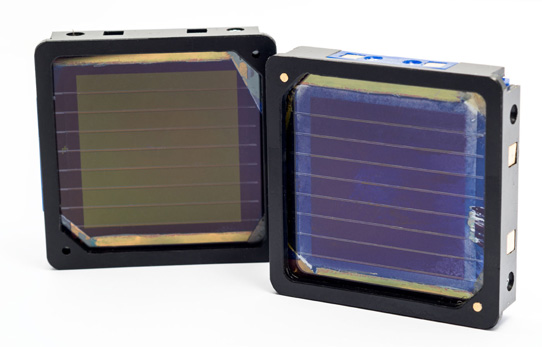At the ITF USA 2015 (Imec Technology Forum) in San Francisco on 13 July, nano-electronics research center Imec of Leuven, Belgium has reported a record 11.3% aperture-area efficiency and 11.9% active-area efficiency for its perovskite thin-film photovoltaic (TFPV) module. The geometrical fill factor was more than 95%, and the efficiency was measured over an aperture area of 16cm2.

Picture: Imec's thin-film perovskite PV modules.
Organometal halide perovskites are considered to be excellent material for thin-film solar cells, as they have shown high conversion efficiencies at the cell level. While the power conversion efficiency of this new class of thin-film solar cells has increased rapidly in the last few years, further improvements are still needed to make thin-film photovoltaics an attractive technology for industrial production, says Imec. Larger-area processing and narrow interconnections are prerequisites for processing efficient thin-film modules.
The record devices have been fabricated using a conventional lab-scale spin coating process. Imec also used a linear coating technique (blade coating) for all the solution-based layers, to prove the industrial viability of the fabrication methods. Using this method, the modules achieved a 9% aperture-area efficiency. Imec reckons that these achievements are key breakthroughs in bringing thin-film solar technology to industrial scalability for applications such as building-integrated photovoltaics (BIPV).
"Imec is steadily improving the conversion efficiencies of its perovskite solar cells and at the same time adjusting the fabrication processes to enable industrial adoption of this promising technology," says Tom Aernouts, R&D manager for thin-film photovoltaics at Imec. "Leveraging our expertise in organic photovoltaics enables us to make rapid progress in enhancing the conversion efficiencies, ultimately aiming at conversion efficiencies of more than 20% for this type of thin-film solar cells."
Imec is developing a platform for glass-based perovskite modules and collaborates with the cross-border Dutch-German-Flemish thin-film PV research initiative Solliance, which involves the partners ECN, Imec, TNO, Holst Centre, TU/e, Forschungszentrum Jülich, University Hasselt and Delft University of Technology. Due to its high power conversion efficiency and stand-alone integration in building elements, both glass-based and thin-film perovskite PV technology are widely considered to be important technologies for the BIPV market. Moreover, Imec is exploring stacking a perovskite cell on top of a silicon solar cell to increase the conversion efficiency of silicon solar cells. The perovskite cell will capture the light that is not absorbed by silicon, enabling conversion efficiencies of more than 30%.

